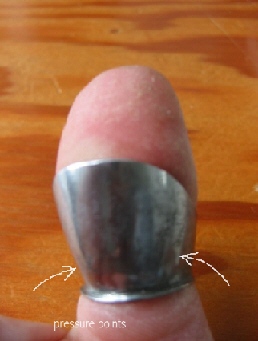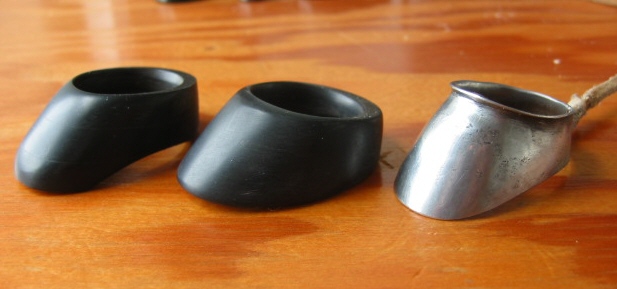

THUMB RING MECHANICS
How to Ensure a good fit for your Thumb Ring
by Adam Karpowicz
The rings I discuss here have the shape similar to the Turco-Persian style used with the Middle-Eastern method of release. Many rings have the hole round, I find rings with oval holes to be more comfortable and easier to adjust. I assume the reader is familiar with the thumb release and knows how to form the thumb lock.
The fit of ring depends on the size of thumb and the hole in the ring has to be the right size for the archer. The ring is placed on the thumb sideways, small opening first, and turned 90 degrees, so the pad of thumb is covered by the lip of ring. In this position the ring should feel rather tight. There are certain critical pressure points to consider.

The thumb’s surfaces at both sides of joint, in contact with the inside of ring, carry the weight of bow (see picture). These are the most important contact points of the thumb with the ring: the pressure wedges the sides of thumb (not the pad) into the ring. This is not to say there is no pressure at the pad/lip surface, but the main contact with the rings should be at the sides of thumb. The ring must not be too wide there and must narrow towards the entry hole for the good "wedging" action. The ring should not be too tight, however, this may cause the thumb to turn blue from constriction.
The position of the contact surfaces is important. Think of the contact surface as a pivot point for the ring. For a right–handed archer during draw, the string rests on the ring at the forward edge of hole, a little to the right (or nearly in-line, looking along the arrow) of the contact surfaces with the thumb’s sides. This causes a slight counterclockwise rotation of the ring, thus releasing the pressure of the back of the ring on the thumb’s knuckle. If the main contact surface was not at the sides of the joint, but on the pad of thumb, the string would be to the left of the pressure area on the pad and the rotation of ring would be clockwise. This would cause the back of ring to cut into the knuckle, making shooting very uncomfortable, certainly so with heavier bows. Such clockwise rotation is also more likely to happen with round-holed rings, where the string tends to slide further towards the flesh and to the left of the pressure point. A leather padding may be then needed at the back of ring (I saw old rings with such padding). If you are unsure about the rings you have, just choose a ring which feels tight during draw, fine tuning can be done later as necessary.
For a clean release, when the hand relaxes, the index finger should come off the thumb first. This is only possible, if it is under the least amount of tension. The thumb should hold the string (assisted by the index finger), and not rely entirely on the inder finger to keep it bent. If the pressure is again on the pad of thumb (and not on the sides as explained above), it will be harder for the thumb to carry the weight of bow and there will be more pressure on the index finger to hold the thumb in place. This will make the clean release difficult, unless one has an exceptionally strong thumb.
The middle, ring and small fingers are curled and pressed hard into the palm and the tip of bent thumb is pressed into the middle finger. Such strong tension for the fingers (except the index of course) helps to hold the thumb, makes the release clean and again allows to draw heavier bows. The lip of ring can cover 1/3 to 2/3 of the thumb’s pad. If too long, it will interfere with the middle finger. Do not worry about the lip not covering your thumb far enough – the thumb is thrown out of the way upon release, so it is not injured. However, if the index finger is tensed holding the thumb or excessively curled around the thumb, the thumb will remain bent long enough for the string to slide on it’s tip and cause injury. It is interesting that other methods that do not advocate "index finger – thumb" sequence of release use rings with long lips, covering most of the thumb pad (for example some Korean rings), presumably to protect it.
Note the surface of the lip inside the ring which covers the pad of thumb is under less pressure, so it does not need to be hollowed, only rounded, although a hollowed lip helps to keep the ring snug to avoid bulk. I usually make it hollow and leave the entire inside of ring a little rough for more friction.
You may find the string slips too far into flesh during draw. It depends on the angle of bending at the joint, it is different for everyone. It also depends on the position of the contact points as explained above, for example the clockwise rotation of ring would cause the string to slide into flesh. Corrections can be made by slightly changing the slope of the area where the string sits. For thumbs bending less, this slope will be less steep, for bending more, more steep towards the ring’s lip. Thick string can help, but a well fitted ring should not require a thick string. There are rings with a small "fence" at the hole to prevent the string sliding into flesh. A properly adjusted ring does not need such devices. The presence of the fence may move the string’s contact point further to the right, causing too much pressure on the pad with the adverse effects as described above.
A ring should not normally require leather padding. If you find the ring too loose (in the winter for example), it can be lined with thin leather for a tighter fit. Also, you can add the Turkish "kulak": a flap of leather to protect the thumb at the contact point with the string. I found kulak can also cover the outside of ring’s lip when more friction is desired there for better control (I think this was in fact the original purpose of kulak).
The shape of the outside surface of ring is not as critical. One can make a perfectly functional ring of thin metal or a ring can be made large with thick walls. The release will not be affected, as long as the lip of ring is rounded and smooth. The rounder, more bulging lip gives a slightly slower release (the string drags on it for a fraction of a second longer), but there is more time for the index finger to come off the thumb. The more "sloping" lip gives a faster release. Beginners may find the round-lipped rings easier to control.

Rings by Peter Cua

Some other rings
And lastly, after some practice, your ring will become too tight. This is perfectly normal – your thumb has enlarged from use. This would be the time to get another ring.
Adam Karpowicz
8/26/2002
Up-dated September 27, 2002